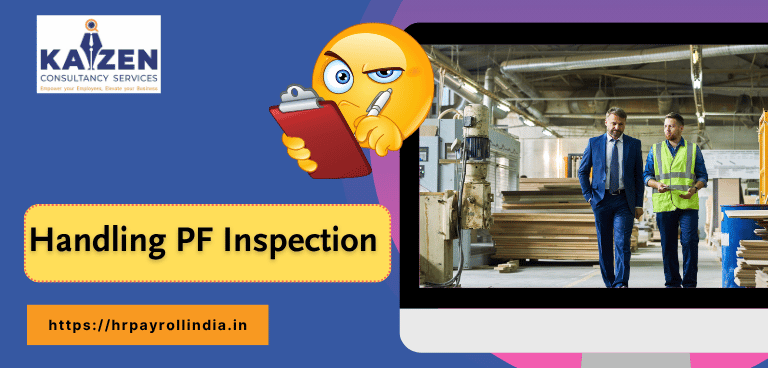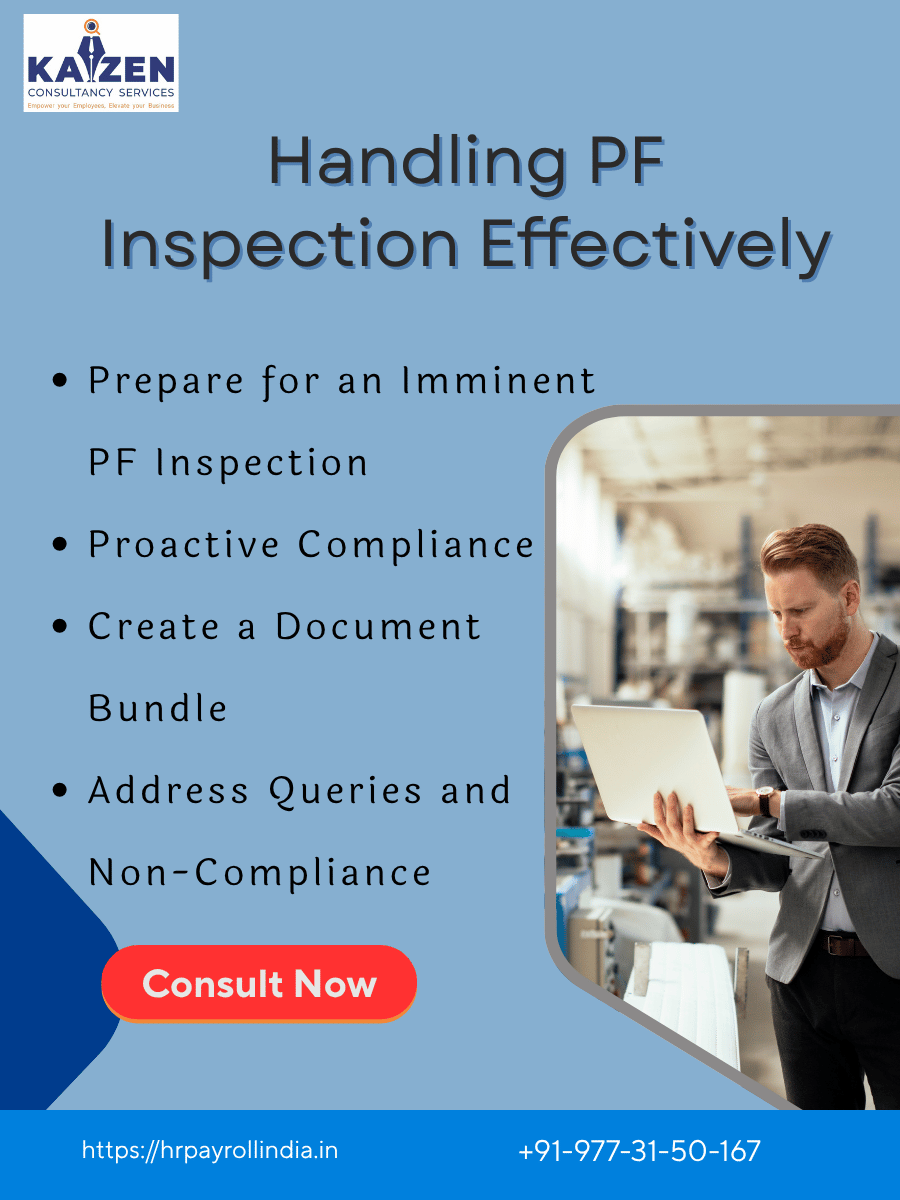How to handle PF Inspection effectively
In India, Provident Fund (PF) compliance is a legal mandate for business owners and an integral part of responsible human resource management. Yet, many businesses—especially local service providers, healthcare professionals, and growing organizations—often struggle not just with routine PF compliances, but also with handling PF inspections effectively. A surprise PF inspection can be intimidating, but if you know what to expect, prioritize compliance, and prepare documentation in advance, you can turn it into a smooth, stress-free process that reinforces your business’s trustworthiness.

Understanding PF Compliance - Essentials for Every Business Owner
Before learning how to handle a PF inspection effectively, it’s crucial to grasp the primary PF compliances that every business—small or large—must follow.
- PF Registration Applicability and Process
- Who Must Register: Every establishment employing 20 or more employees must register with the Employees’ Provident Fund Organization (EPFO).
- Timeline: Registration must take place within one month after reaching the employee threshold.
- Why It Matters: Failure to register on time can lead to significant penalties and legal complications.
- Timely and Accurate PF Contributions
- Contribution Rate: Both employer and employee contribute 12% of the eligible wages; in some cases, the rate is 10%.
- Deadlines: Contributions must reach the EPFO by the 15th of the following month.
- Penalty for Late Payment: Interest at 12% per annum on defaults, along with damages between 5% and 100% of the unpaid amount.
- Best Practice: Use automated payroll solutions to minimize errors and delays.
- ECR (Electronic Challan cum Return) Filing
- Monthly Filing: Submission of ECR every month is mandatory. This includes employee-wise details such as UAN, salary, and PF deductions.
- Importance of Accuracy: KYC data (Aadhaar, PAN, bank details) must be correct to avoid claim settlement delays.
- Annual PF Returns and Documentation
- Key Forms: Form 3A (employee-wise statement) and Form 6A (annual summary) must be filed by April 30 each year.
- Document Retention: All relevant PF documents should be retained for at least seven years.
- Employee Onboarding & Exit Procedures
- UAN Generation: Every eligible employee must be allotted a Universal Account Number.
- Exit Formalities: Prompt transfer and settlement of PF accounts on employee resignation or retirement.
- Grievance Handling and Audit Preparedness
- Complaint Redressal: Businesses must have mechanisms to resolve employee grievances concerning PF.
- Audit Preparation: Maintain updated and accurate records to face surprise audits with confidence.
What is a PF Inspection?
A PF inspection is an official audit conducted by the EPFO to ensure employers are complying with all statutory requirements relating to employee provident fund contributions, filings, and documentation. Inspections may be:
- Routine: Part of scheduled audits by EPFO authorities.
- Triggered: Initiated through complaints by employees or tip-offs about non-compliance.
During the inspection, the EPFO officer reviews your establishment’s employment, payroll, and contribution records.
When are PF Inspections conducted?
Common Triggers for PF Inspections
- Employee complaint related to PF non-remittance or discrepancies.
- Random audits by EPFO regional offices.
- Discrepancies noticed in periodic returns or ECR filings.
- Irregularities flagged by other government agencies.
Regular compliance and transparent documentation minimize the likelihood—and risk—of a negative inspection outcome.
How to Handle PF Inspections Effectively: Step-by-Step
- Proactive Compliance: The Foundation for Stress-Free Inspections
The most effective way to handle a PF inspection is to already have robust compliance systems in place. Here’s how:
- Automate Record-Keeping: Use cloud-based payroll software with built-in PF compliance features.
- Create Compliance Checklists: Maintain checklists for monthly, quarterly, and annual submissions.
- Internal Audits: Conduct periodic self-audits to spot and correct discrepancies before an external inspection.
- Prepare for an Imminent PF Inspection
As soon as you receive notice of an inspection (or anticipate one after a complaint):
Gather Key Documents Efficiently
- PF Registration Certificate.
- Monthly PF Challans & Payment Receipts.
- ECR Filings and Acknowledgements.
- Salary Registers & Payroll Statements.
- Employee KYC Details (UAN, Aadhaar, PAN, bank details).
- Attendance Records.
- Annual Returns: Form 3A, 6A.
- Copies of Correspondence with EPFO and Employees.
- Grievance Redressal Logs (if any).
Create a Document Bundle
Organize all documents by financial year and ensure digital PDFs are also readily accessible.
- Cooperate with Inspecting Officers Effectively
- Designate a Point Person: Assign one HR or finance team member to coordinate with the inspector and answer queries.
- Maintain Courteous Communication: Greet the inspector, respond politely, and avoid being confrontational.
- Clarity in Responses: If a question is unclear, ask for clarification rather than guessing.
- Transparency: Present all documents as requested—don’t try to hide or manipulate records.
- Address Queries and Non-Compliance Issues Proactively
If the inspector highlights any deficiencies or lapses:
- Clarify Immediately: If data is missing or unclear, explain and attempt to provide missing details quickly.
- Acknowledge Genuine Errors: If unintentional mistakes are found, admit them and outline corrective steps.
- Rectify Errors Promptly: Make necessary payments, update records, and show proof of rectification as soon as possible.
- Seek Extension if Needed: If more time is needed to produce records, make a formal request with estimated timelines.
- Common Areas of Scrutiny During PF Inspections
Understanding what inspectors commonly check helps you prepare more effectively:
Compliance Area | What Inspector Checks | Common Issues/Queries |
PF Registration | Registration, included all eligible employees? | Missed part-time/contract staff |
Monthly Contributions | Timely deposit, accurate computation | Lapses or underpayment |
Employee KYC | UANs generated, KYC updated | Unlinked/incomplete KYC |
Annual Returns | Timely filing, accurate data | Delayed or missing returns |
Payroll Records | Attendance, wage calculation | Mismatches in salary structure |
Exit Formalities | Proper transfer/settlement documents | Delayed PF transfer/settlement |
Grievance Response | Resolution of employee complaints | Incomplete records |
Tips for Handling a PF Inspection Effectively
- Stay Calm and Professional: Panicking or resisting can escalate matters.
- Organize Regular Training: Update HR and payroll teams about latest PF rules.
- Use Checklists: Regularly update a PF compliance checklist.
- Keep Backup Copies: Maintain both digital and physical copies of critical documents.
- Record the Inspection: Politely note the queries and requested documents for future reference.
- Consult Professionals: If the inspector raises complex or legal queries, consult a PF consultant or labor law expert for accurate responses.
After the Inspection: What to Do Next
- Review and Implement Recommendations
Inspectors may issue a written report or list of observations—address each point systematically:
- Correct Errors Quickly: Deposit outstanding dues, file missing returns, and complete document updates.
- Submit Compliance Proofs: If required, send documents evidencing rectification to the EPFO office.
- Document Everything: Maintain a record of communications and updates for future reference.
- Avoiding Future Trouble: Build a PF-Ready Culture
- Conduct annual compliance audits.
- Regularly update employee records.
- Schedule periodic training sessions for your HR and finance teams.
- Monitor regulatory updates from the EPFO.
PF Inspections Effectively: Do’s and Don’ts Table
Do’s | Don’ts |
Maintain updated, accurate PF records | Ignore inspection requests |
Assign a knowledgeable point person | Provide incomplete/inaccurate records |
Use technology for compliance and record-keeping | Delay in responding to the inspector’s queries |
Rectify mistakes as soon as discovered | Attempt to mislead or conceal information |
Stay calm, polite, and cooperative | Argue or become aggressive with authorities |
Regularly review compliance checklists | Wait for inspection notices to review errors |
Role of Technology in Managing PF Inspections Effectively
Implementing cloud-based HR and payroll solutions isn’t just a matter of convenience—it’s a compliance necessity for modern businesses. Here’s how digital tools make PF inspections easier:
- Automated Reminders: Track deadlines for contributions and filings.
- One-Click Reports: Generate ECR, challans, and registers instantly.
- Secure Storage: Store employee documents in compliance-friendly formats.
- Audit Trails: Maintain digital audit logs of all compliance actions.
Popular tools in India include GreytHR, Zoho Payroll, and QuickBooks Payroll.
Real-World Mistakes to avoid during PF Inspections
- Neglecting to Update Latest KYC Information: Leads to failed return filings and claims.
- Missing Records for Outsourced or Contract Workers: All eligible workers must be covered, even if not full-time.
- Failure to File Returns After Ownership Change: Always notify the EPFO of changes in management or ownership.
- Not Resolving Employee Complaints: Unresolved issues can spark inspections and legal complications.
PF Inspection Checklist - Be always ready
- Have your latest PF registration documents
- Keep the last 7 years’ PF returns, challans, and salary registers
- Employee-wise ECR and KYC records
- Documentation for retirees, resigned, and transferred employees
- Up-to-date grievance redressal register
- Written communications with EPFO
Frequently Asked Questions
Politely inform the inspector and request a reasonable extension. Begin preparing missing documents immediately and keep the inspector updated on your progress.
Yes, inspectors may directly interact with employees to verify their employment status, wage payments, and PF contribution status.
Most minor, genuine mistakes are rectifiable without penalties if addressed transparently and promptly. Penalties are likely for willful default, repeated offenses, or concealment attempts.
While there is no fixed frequency, inspections may be routine (annually or biennially) or triggered by complaints or anomalies.

PF Inspections handling
Handling PF inspections effectively requires foresight, preparation, and a proactive compliance mindset. By focusing on robust documentation, technological automation, regular self-audits, and transparent interactions with authorities, business owners not only reduce the risk of penalties but also build unwavering trust with both employees and regulatory bodies.
A culture of PF compliance isn’t just about “passing” inspections; it’s about sustainable business growth and reputation in India’s competitive landscape.
Empower your HR and payroll teams with training and modern tools, keep communication open with all stakeholders, and remember—PF inspection is an opportunity to prove your business’s integrity and commitment to employee welfare.
Contact our expert Labour Law Consultants – Kaizen Consultancy Services today to streamline your construction compliance!
